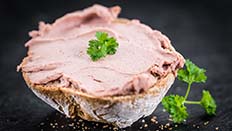Meats and Sausages
Leberstreichwurst (Liver Sausage)
Leberstreichwurst is an Austrian spreadable liver sausage. It was already popular in Vienna in 1820-1830 as mentioned by Friedrich Schlögl in his 1981 article “Die Saison der Wurst”-The Season of the Sausage. Katharina Prato writes in her 1869 cookbook: “Süddeutsche Küche’-Southern German Cuisine about liver and blood sausage. Leberstreichwurst was officially incorporated into 1912 Austrian “Österreichischen Lebensmittelcodex” (Austrian federal index of foods). There are 3 variants of Austrian spreadable liver sausage, each having different composition of meats with liver accounting from 15 to 30%.
| Meats | Metric | US |
|---|---|---|
| Pork liver | 300 g | 0.66 lb |
| Lean pork | 250 g | 0.55 lb |
| Pork belly skin included, fat trimmings | 450 g | 0.99 lb |
Ingredients per 1000g (1 kg) of meat
| Salt | 16 g | 2.5 tsp |
| Cure #1 | 1.5 g | 1/4 tsp |
| White pepper | 2.0 g | 1 tsp |
| Marjoram | 1.0 g | 1/2 tsp |
| Cinnamon | 0.5 g | 1/4 tsp |
| Ginger | 0.3 g | 1/8 tsp |
| Onions | 30 g | 1 oz |
Instructions
- Dice onions finely and fry in fat on low heat until glassy and golden.
- Boil meats and fat (except liver) in water staying below the boiling point.
- Drain and cool. Grind meats, fat and onions through 8 mm (3/8”) plate.
- Grind again through 3 mm (1/8”) plate. (The process of grinding meats and liver through 3 mm (1/8”) plate can be performed in food processor).
- Grind the raw liver through 3 mm (1/8”) plate.
- Mix meats, fat, liver and all ingredients together.
- Stuff into 36-40 mm natural or synthetic casings.
- Cook in water at 80° C (176° F) for 45 minutes.
- Immerse in cold water for 5-10 minutes.
- Cool in air. At this stage, the sausages stuffed in natural casings were often cold smoked (18° C/64° F) for 2-4 hours until they developed the gold-brown color.
- Refrigerate.


















